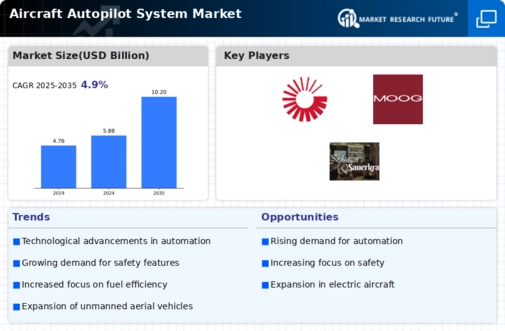Rising Air Traffic
The Global Aircraft Autopilot System Industry is significantly influenced by the rising air traffic globally. As more individuals and goods are transported by air, the demand for efficient and reliable autopilot systems increases. According to projections, global air traffic is expected to double over the next two decades, necessitating the need for advanced autopilot technologies to manage this growth effectively. Autopilot systems play a crucial role in optimizing flight operations, reducing delays, and enhancing overall passenger experience. This surge in air traffic is likely to propel the market towards its anticipated growth trajectory, reaching 10.2 USD Billion by 2035.
Market Growth Chart
The Global Aircraft Autopilot System Industry is projected to grow from 5.88 USD Billion in 2024 to 10.2 USD Billion by 2035, reflecting a CAGR of 5.17% from 2025 to 2035. This growth trajectory indicates a robust demand for advanced autopilot systems across various aviation sectors.
Technological Advancements
The Global Aircraft Autopilot System Industry is experiencing rapid technological advancements, particularly in artificial intelligence and machine learning. These innovations enhance the capabilities of autopilot systems, allowing for improved navigation, obstacle detection, and decision-making processes. For instance, the integration of advanced sensors and data analytics enables real-time adjustments to flight paths, thereby increasing safety and efficiency. As these technologies continue to evolve, they are expected to drive market growth significantly, contributing to the projected market value of 5.88 USD Billion in 2024 and potentially reaching 10.2 USD Billion by 2035.
Increasing Demand for Automation
The Global Aircraft Autopilot System Industry is witnessing a growing demand for automation in aviation. Airlines and operators are increasingly adopting autopilot systems to enhance operational efficiency and reduce pilot workload. This trend is particularly evident in commercial aviation, where the need for cost-effective solutions is paramount. The automation of flight operations not only improves safety but also allows for better fuel management and scheduling. As a result, the market is projected to grow at a CAGR of 5.17% from 2025 to 2035, reflecting the industry's shift towards more automated flight systems.
Regulatory Support and Standards
The Global Aircraft Autopilot System Industry benefits from robust regulatory support and established standards that promote the adoption of advanced autopilot technologies. Regulatory bodies, such as the Federal Aviation Administration (FAA) and the European Union Aviation Safety Agency (EASA), are actively developing guidelines that encourage the integration of sophisticated autopilot systems in both commercial and military aircraft. This regulatory framework not only enhances safety but also fosters innovation within the industry. As compliance with these regulations becomes increasingly critical, manufacturers are likely to invest more in developing advanced autopilot solutions, further driving market growth.
Emerging Markets and Investment Opportunities
The Global Aircraft Autopilot System Industry is poised for growth, particularly in emerging markets where aviation infrastructure is rapidly developing. Countries in Asia-Pacific and Latin America are investing heavily in their aviation sectors, leading to increased demand for advanced autopilot systems. These regions are witnessing a surge in new aircraft orders, which necessitates the integration of modern autopilot technologies. As investments in aviation infrastructure continue to rise, the market is expected to benefit from these developments, contributing to the overall growth of the industry.













